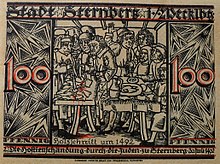Serial ticket
Serial notes are emergency notes made of paper that were printed and circulated in Germany during the inflationary period from 1917 to 1923 by cities and municipalities, but also by private individuals as a replacement for the missing change. Their validity was limited and only lasted a few days at trade fairs or other events.
meaning
Their face value starts at fractions of pennies . Usually, however, a series of notes consists of 10 pfennig, 20 pfennig, 50 pfennig, 75 pfennig and one mark . The nominal value rarely exceeds the value of 10 marks.
Serial notes are often artistically designed, executed as paper cuts or multi-colored prints. There are even photo series that show the place or the surroundings. Serial notes were intended for emergency money collectors who collected this money like postage stamps in emergency money albums. Series tickets were often sold in specially made "bags" that provide information about the series.
The issuers of the tickets, cities, municipalities, but also innkeepers, companies and associations achieved additional income through the sale of these series tickets.
The term serial notes of the new generation includes those serial notes that were issued several generations later. Here are in particular the notes from Bad Godesberg, Bad Saulgau, Bonn, Esslingen, Fellbach, Kernen, Arnsburg Monastery, Korb, Lich, Marburg, Nidda, Remseck, Schwäbisch Gmünd, Schwalmstadt-Treysa, Stuttgart-Neugereut, Urbach, Waiblingen, Weinstadt, Wiesbaden and Winnenden to be mentioned.
Selected examples
Berlin city receipts from 1921
In Berlin , a series of 50-pfennig city cash register bills was published dated September 9, 1921. It consists of 20 bills, each with one note per city district. The other side of all notes in the series shows the Berlin bear and the serial number on the left, the embossed seal of the magistrate on the right and the signatures of Mayor Gustav Böß and city treasurer Ernst Karding in the middle .
District 1 Mitte - Berlin City Hall in 1819
District 2 Tiergarten - First steamship on the Zelten-Charlottenburg line
District 3 Wedding - The Gesundbrunnen in 1760
District 4 Prenzlauerberg - Mühlenberg in front of the Prenzlauer Tor in 1822
District 5 Friedrichshain - crossing to the Stralau fish haulage around 1825
District 6 Kreuzberg - The Hallesche Tor in 1845
District 7 Charlottenburg - Berliner Strasse in Charlottenburg around 1820
District 8 Spandau - Spandau around 1800
District 9 Wilmersdorf - hunting lodge built in the 16th century
District 10 Zehlendorf - Church in Dahlem 14th century
District 11 Schöneberg - Dorf Schöneberg around 1820
District 12 Steglitz - Former church of Steglitz from the 13th century
District 13 Tempelhof - "Gastwith Langens" in Templo around 1780
District 14 Neukölln - "The village of Rixdorf" around 1820
District 15 Treptow - Gasthaus in Treptow around 1820
District 16 Köpenick - Köpenick around 1820
District 17 Lichtenberg - Lichtenberg around 1790
District 18 Weißensee - Weißensee around 1800
District 19 Pankow - homestead in Pankow around 1770
District 20 Reinickendorf - mill in Tegel around 1800
Eisenach 1921 "Luther on the Wartburg"
In the Wartburg town of Eisenach , a series of six 50-pfennig notes was published with the imprint “In memory of the arrival of Dr. Martin Luther's at Wartburg May 4, 1521 ”. On the left is the Wartburg , in the middle the Eisenach city coat of arms and on the right the Eisenach center. Below you can see the signatures of the Lord Mayor , Chamberlain and the Really Secret Council of Eisenach. The validity was limited to May 31, 1921.
The backs show different motifs from Luther's stay in the Wartburg.
Emergency money from the city of Treuenbrietzen
The emergency money series of six notes from the city of Treuenbrietzen was designed by Heinz Schiestl . All front pages have the title “Notgeld der Stadt Treuenbrietzen” and the marginal inscription “This voucher will be accepted as part of payment by the city coffers. It loses its validity 1 month after the announcement ”. The notes were issued from July 1921 and have two signatures from the magistrate.
Back of the bill C: Images of sons of the city:
composer Friedrich Heinrich Himmel (left)
reformer Martin Chemnitz (center)
Chancellor Johannes Weinlob (right)Back of the note D: "Elector Ludwig I. (Bayer) grants land to the Treuenbrietzen citizenship"
Sternberger emergency notes
In 1922 the city of Sternberg , like many other German cities in the Weimar Republic , printed a series of its own emergency notes. The front shows a uniform view of the city from 1492. For the back, representations from the legend of the Sternberg host sacrilege were chosen . The Sternberger emergency money was issued without comment "as if it were a historical, truthful event."
Serial tickets of the SPD
The serial notes of the SPD from the city of Emden dated November 9, 1921 show portraits of Karl Marx and Friedrich Engels on the front .
Individual evidence
- ↑ Peter Ortag: Jewish culture and history. Foreword p. 7, Federal Agency for Civic Education, Bonn 2004.










































